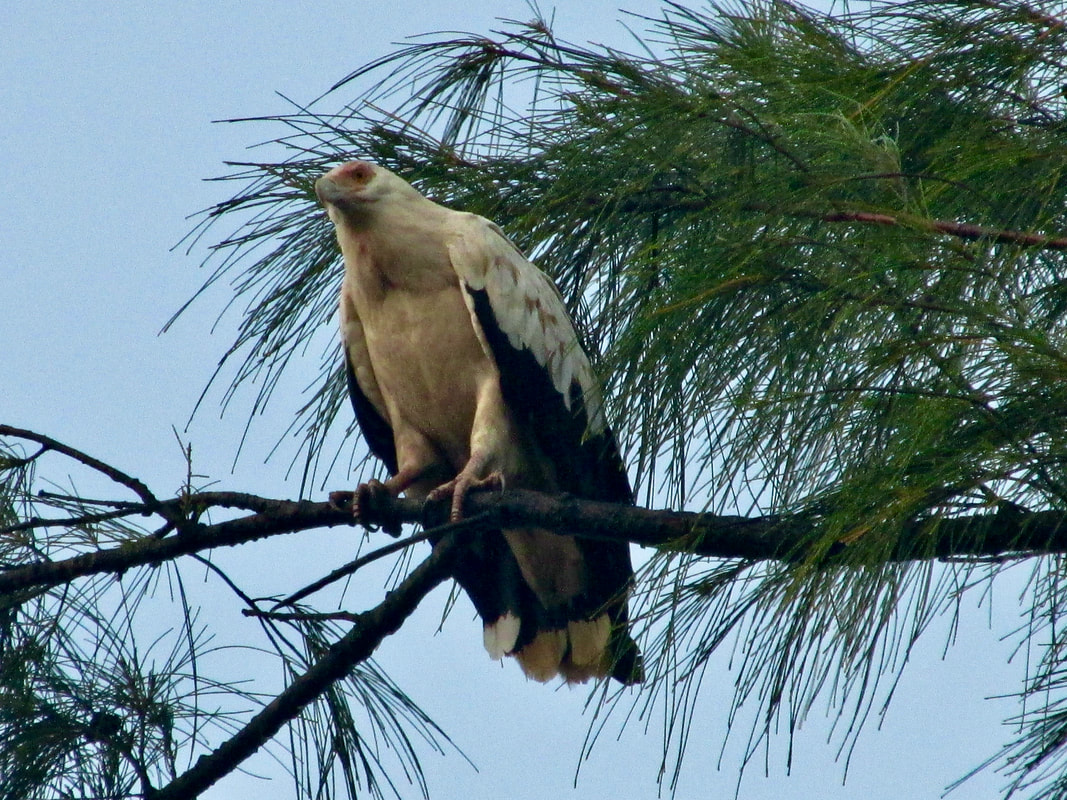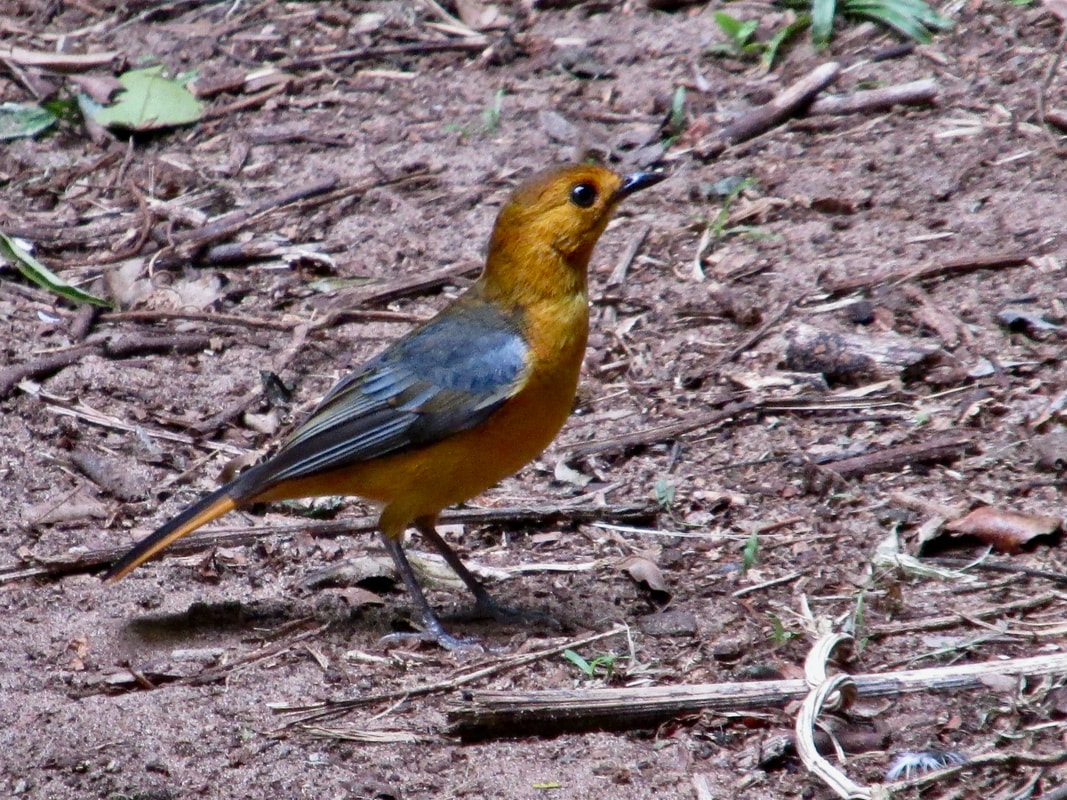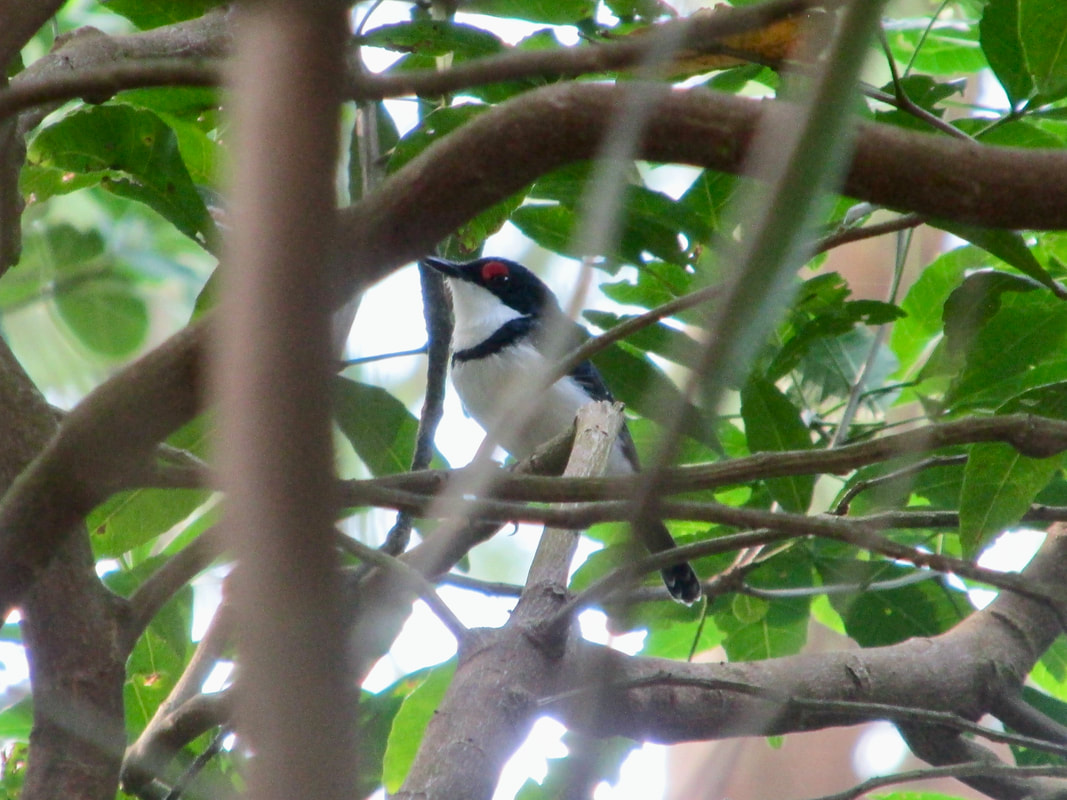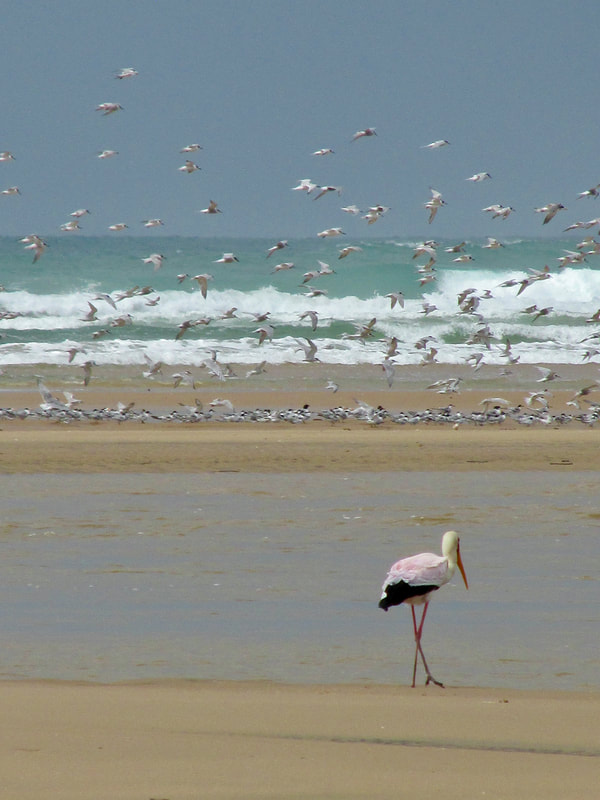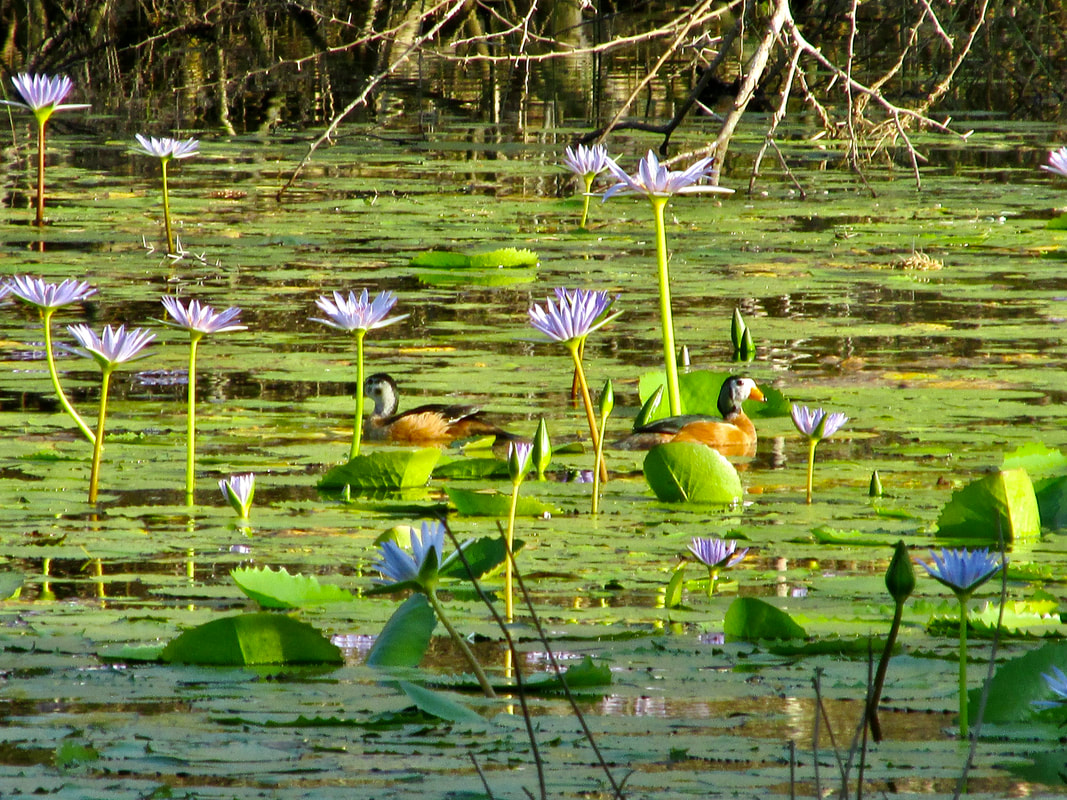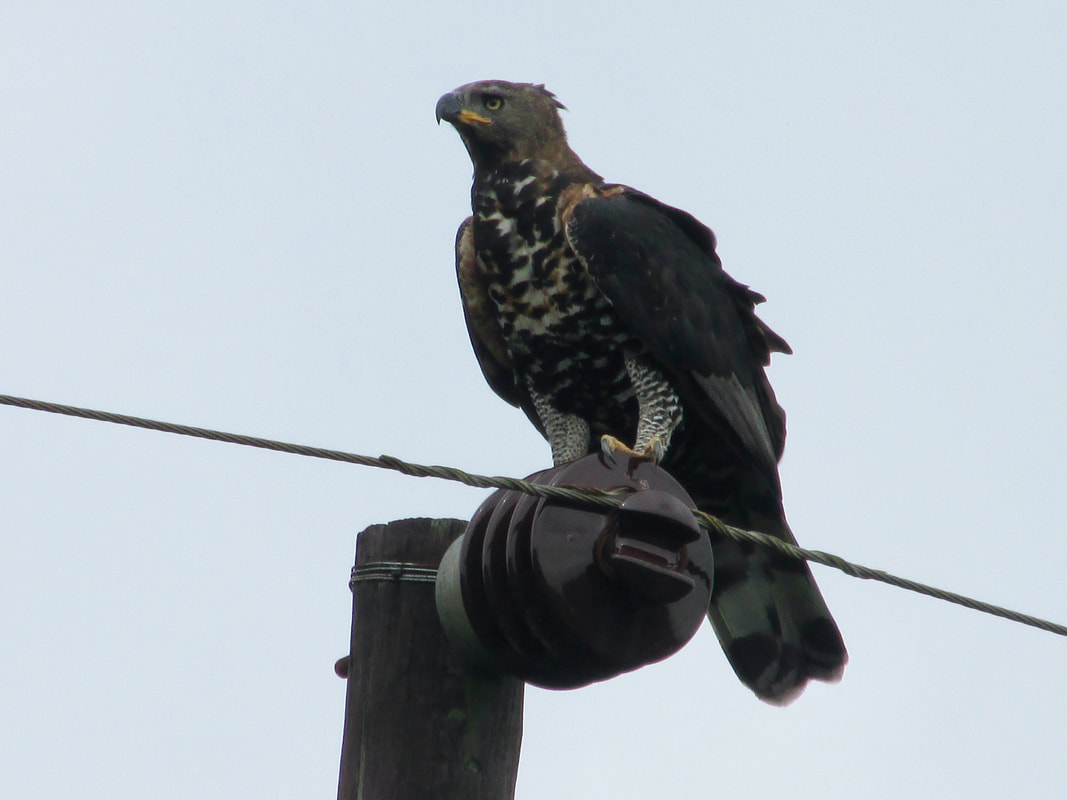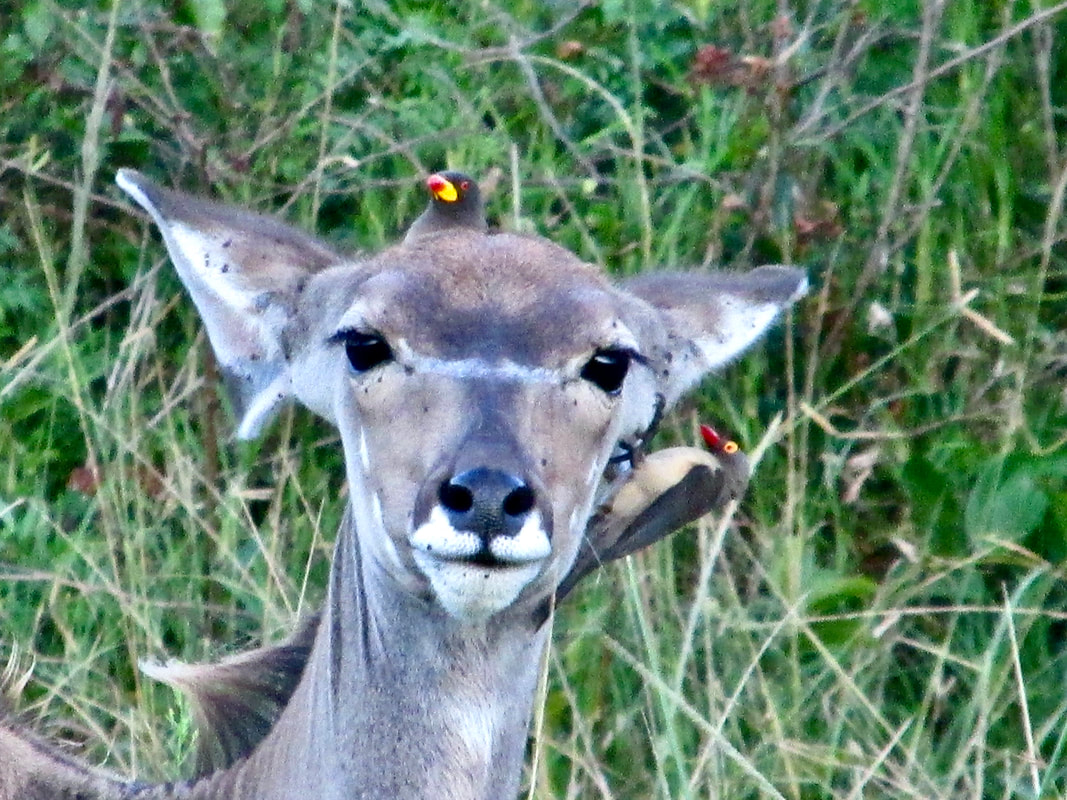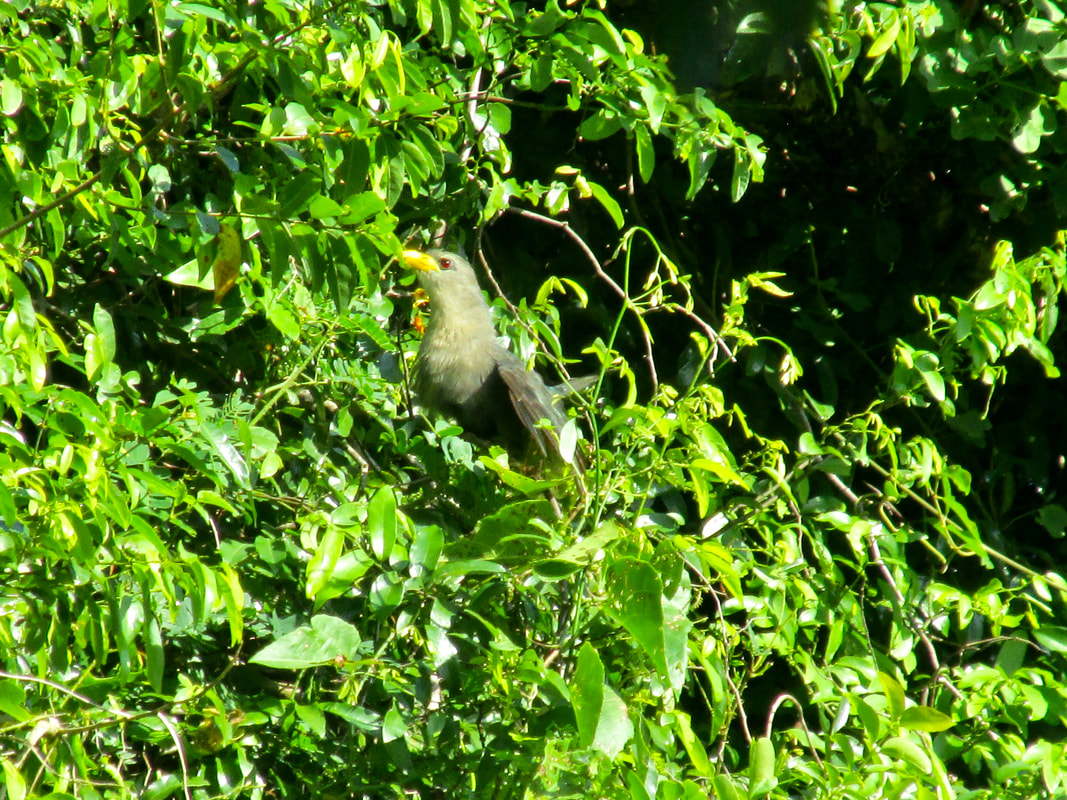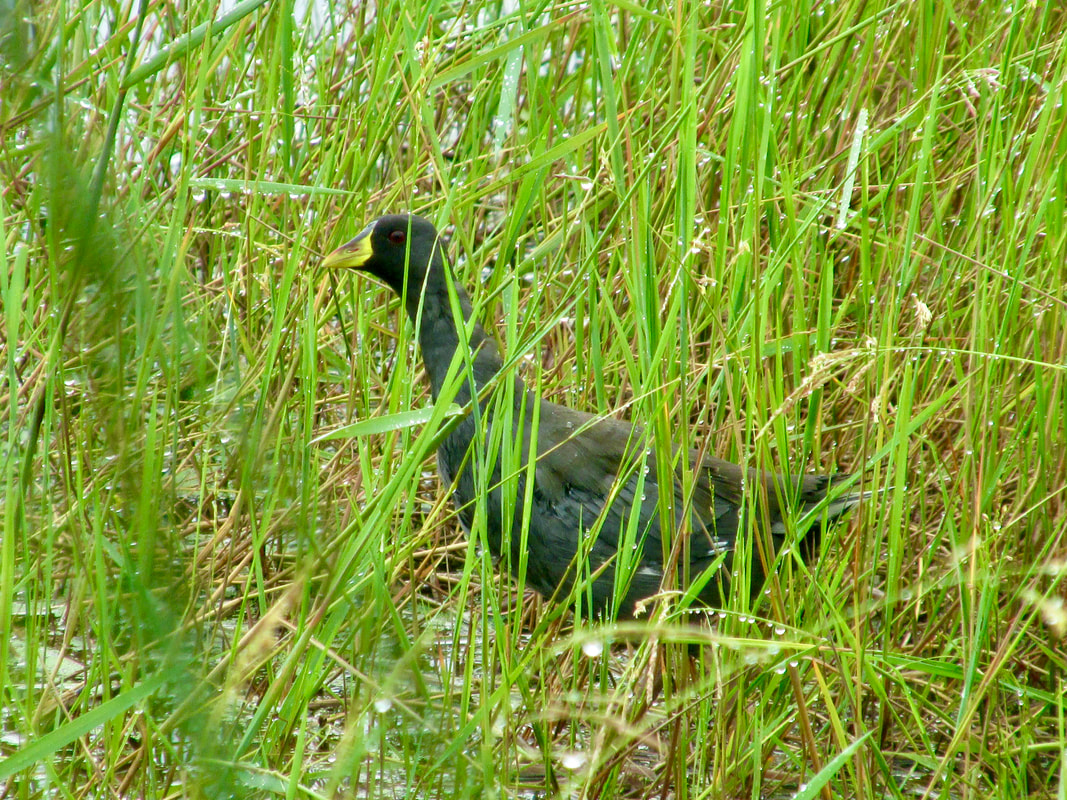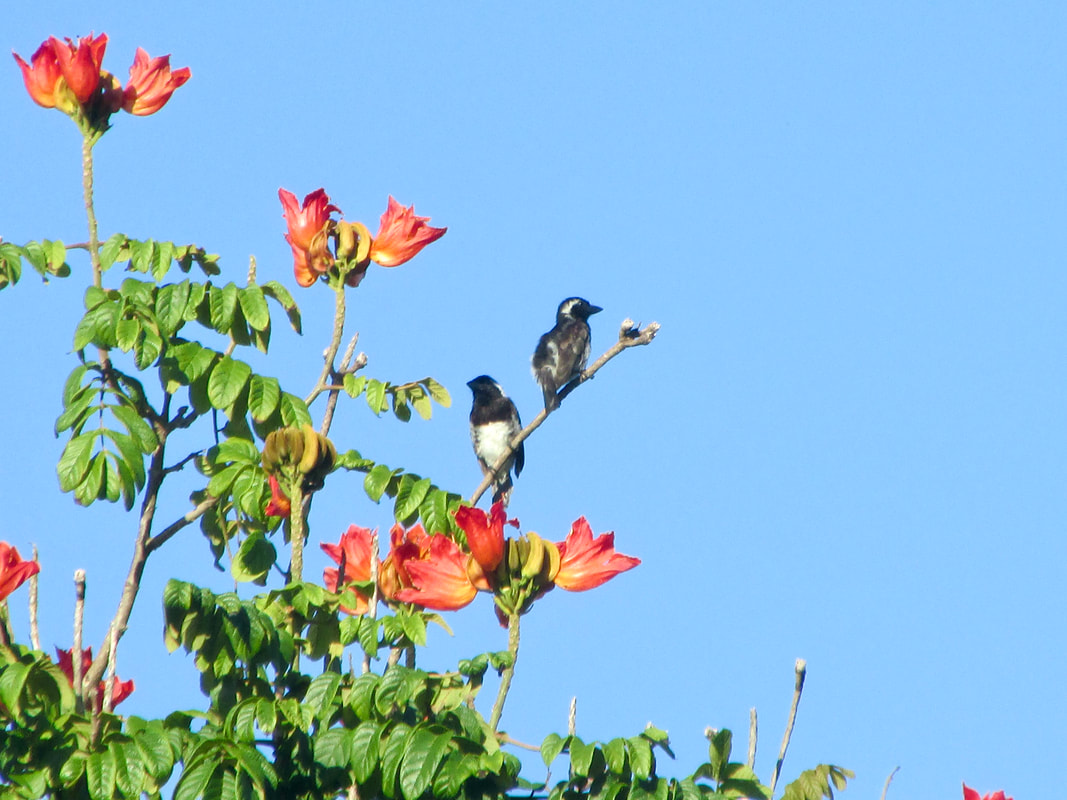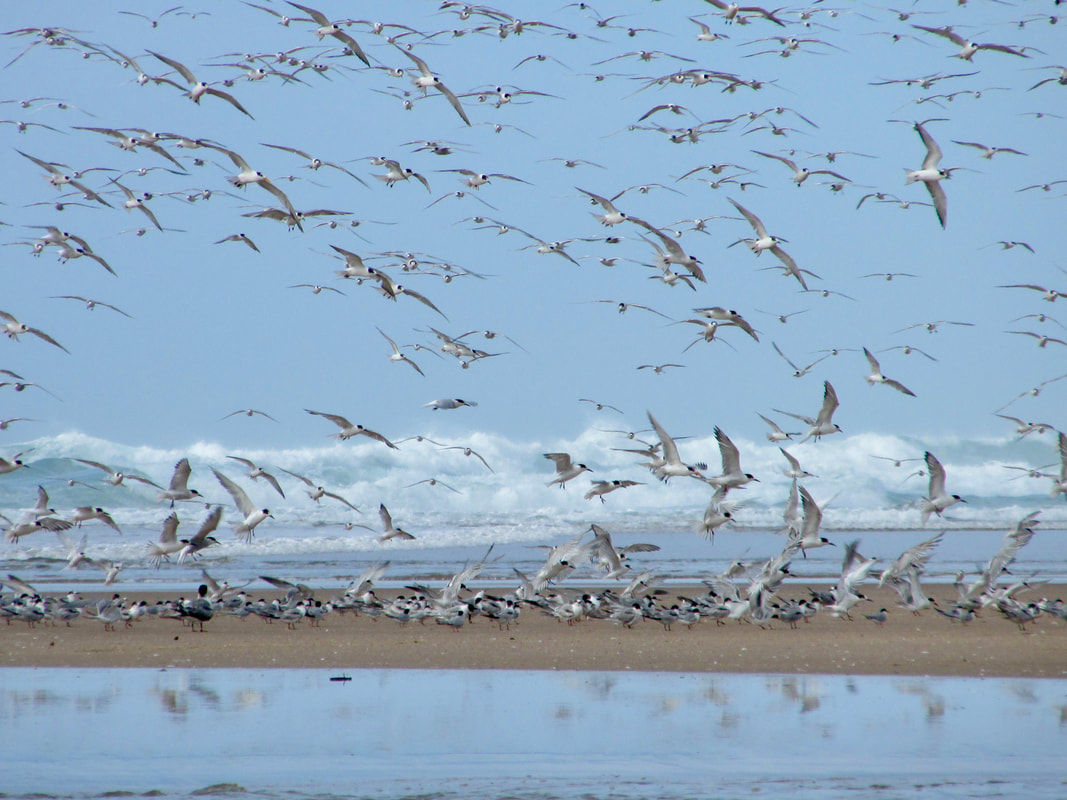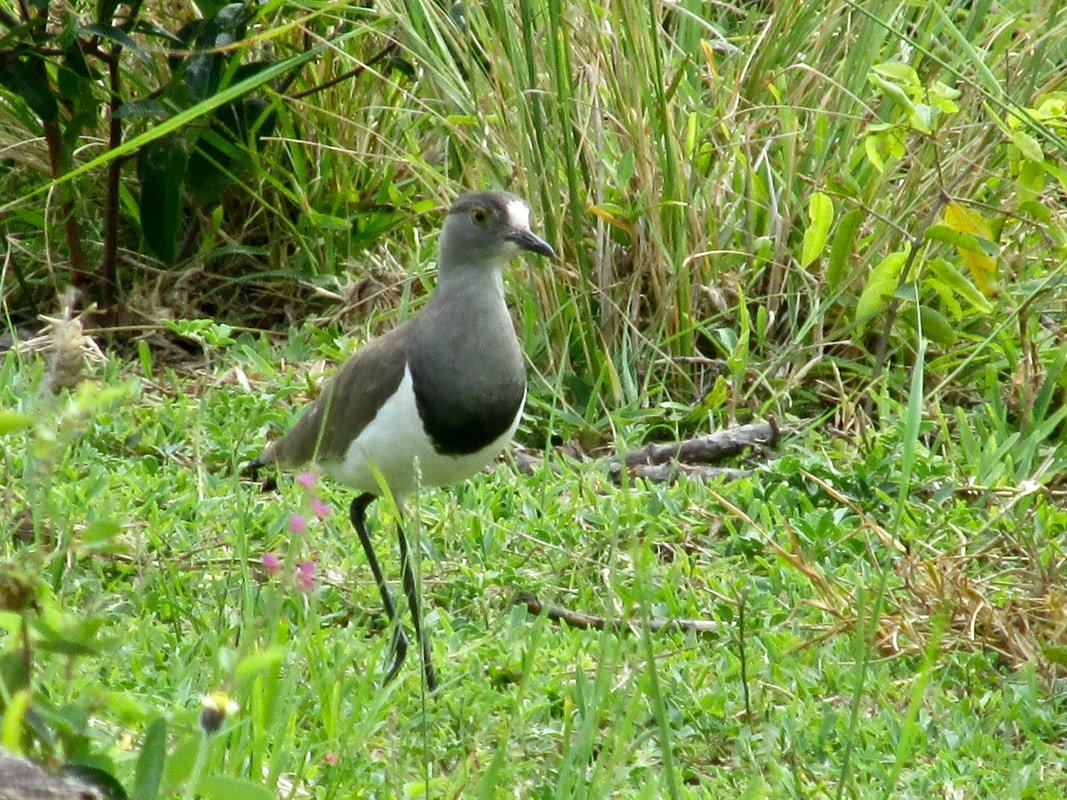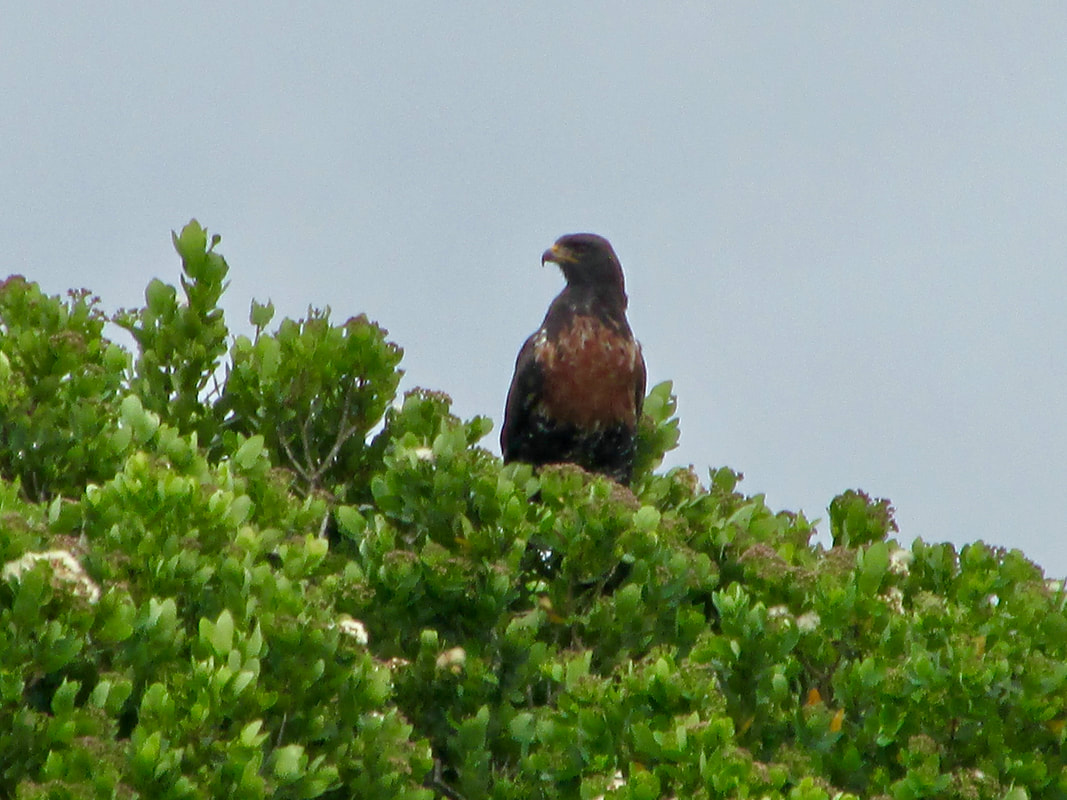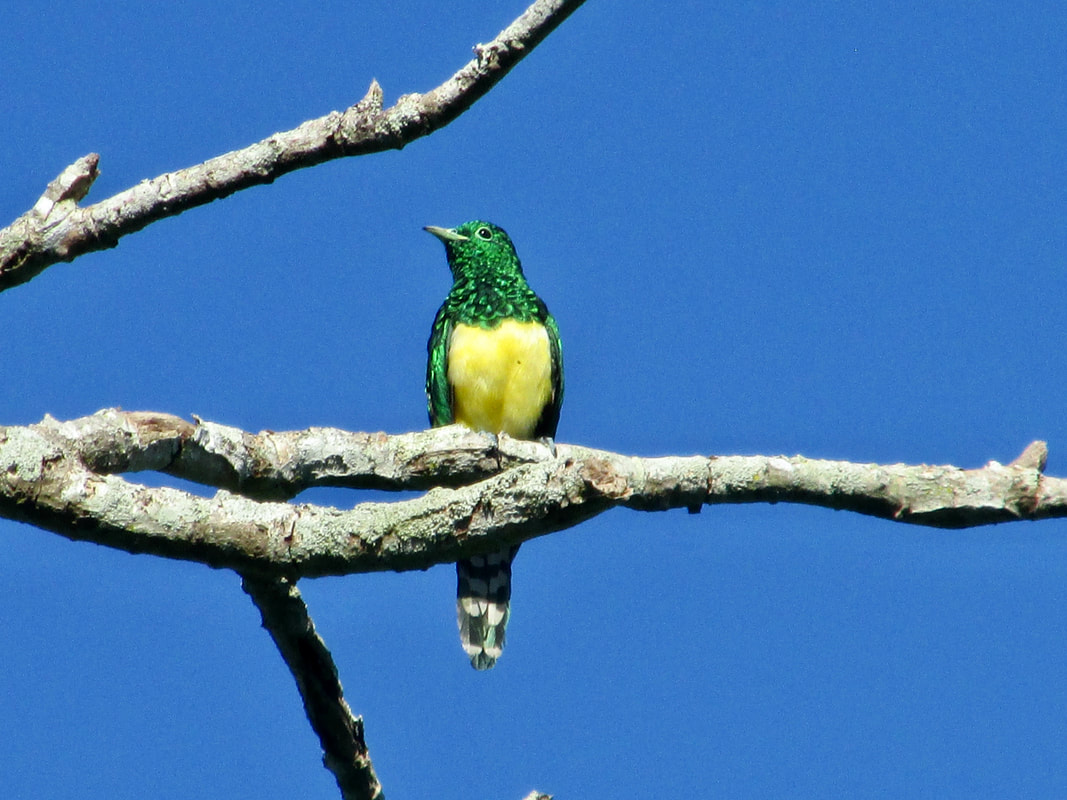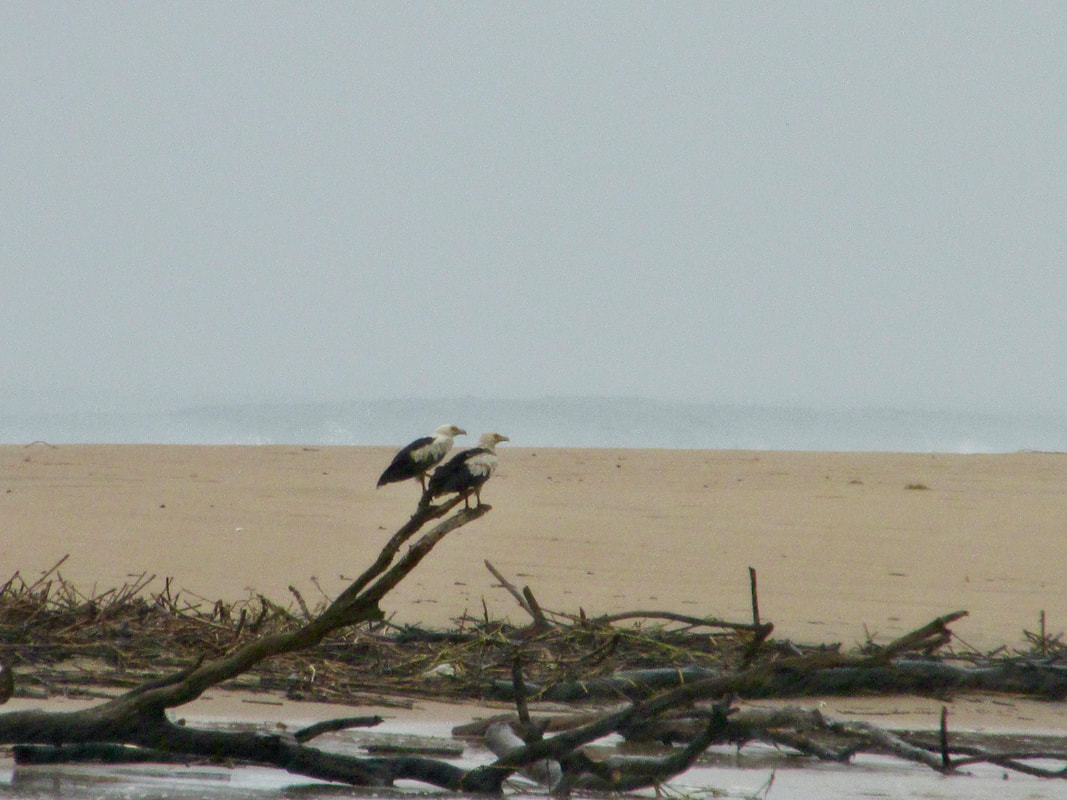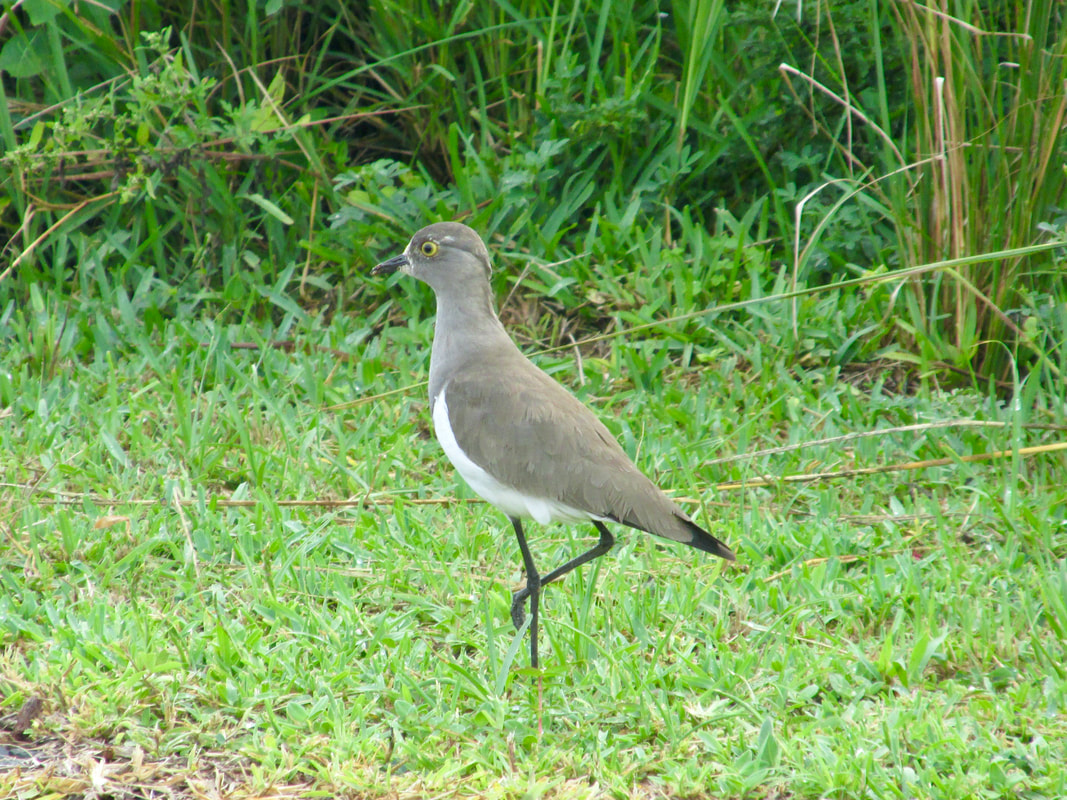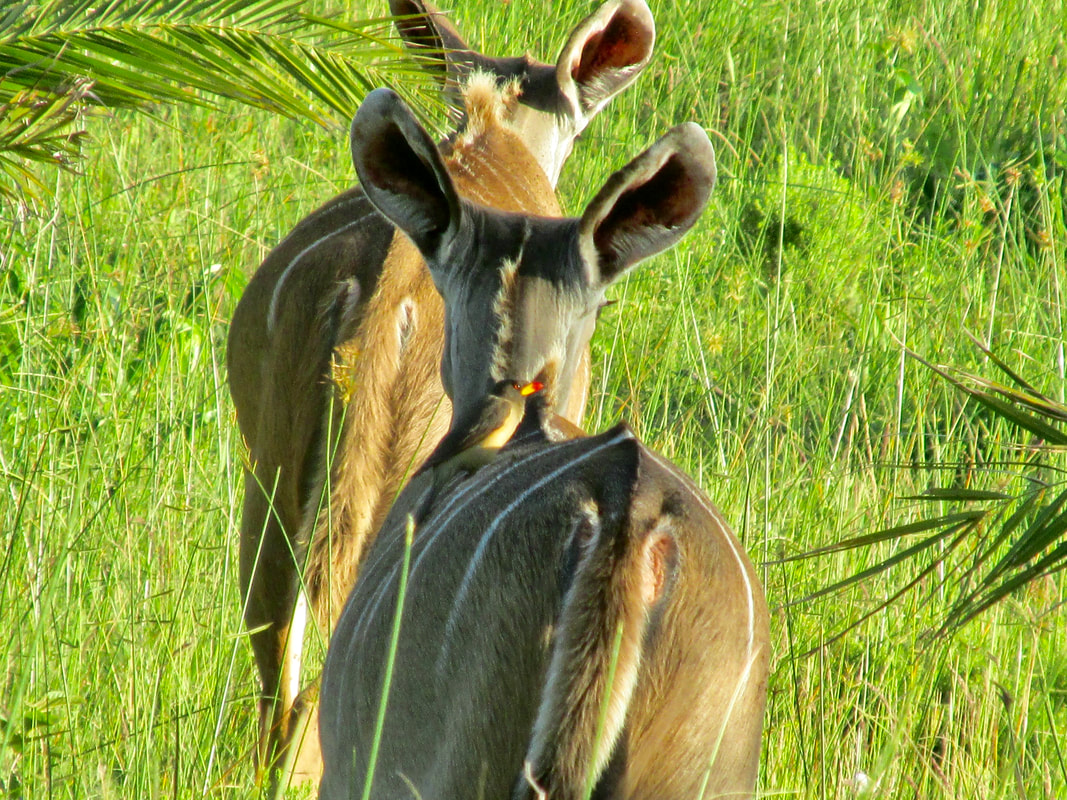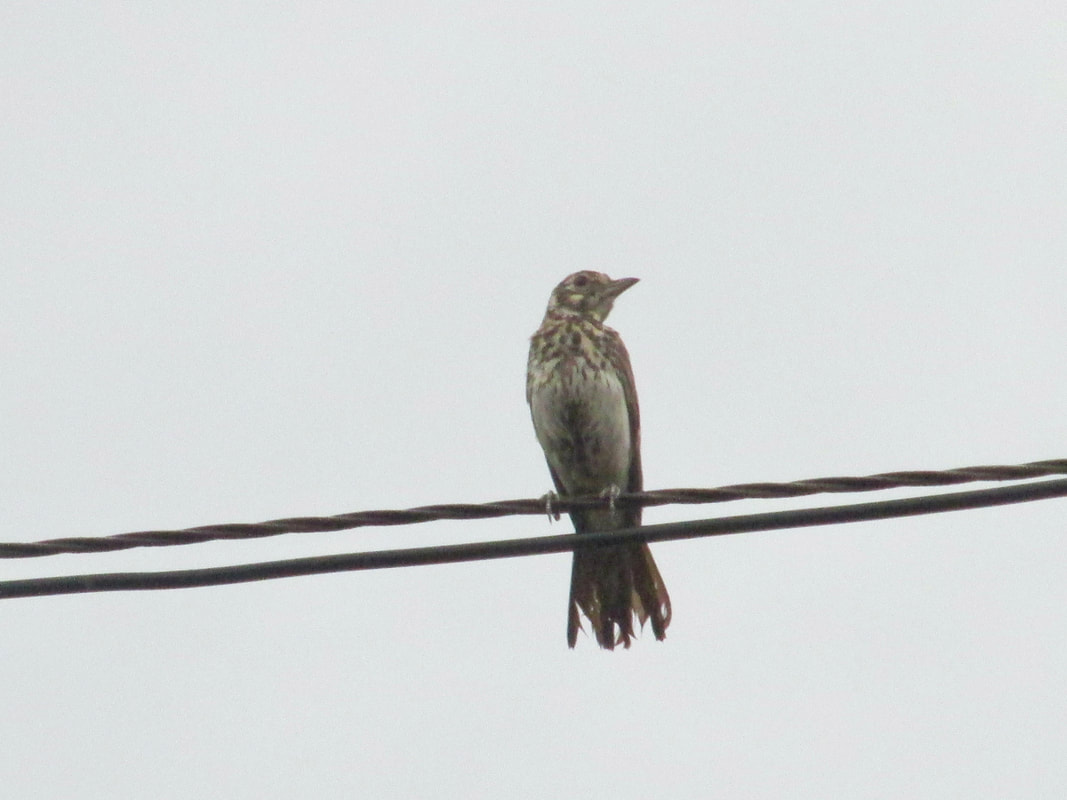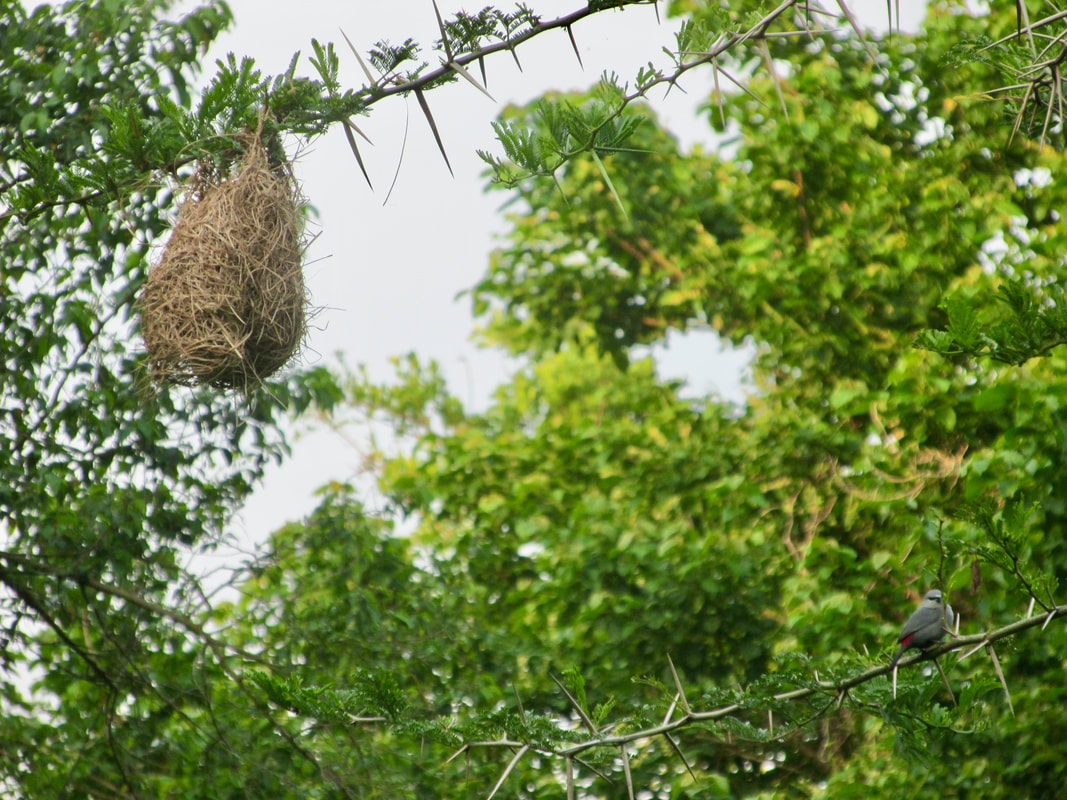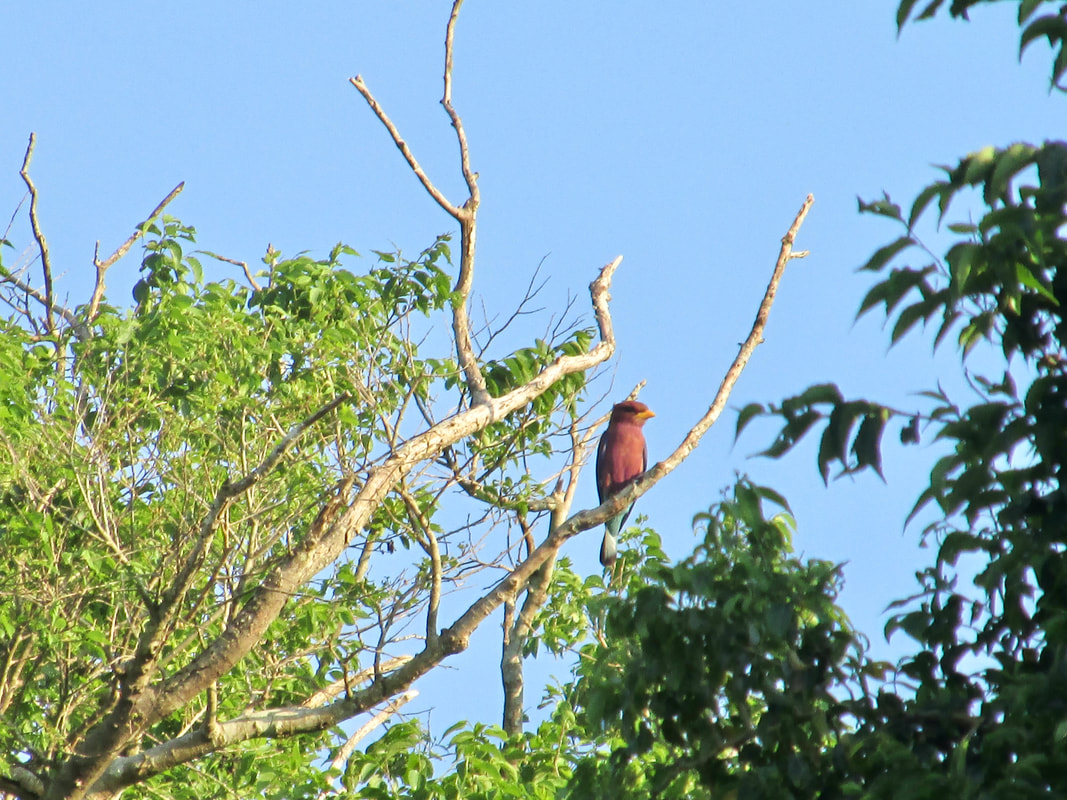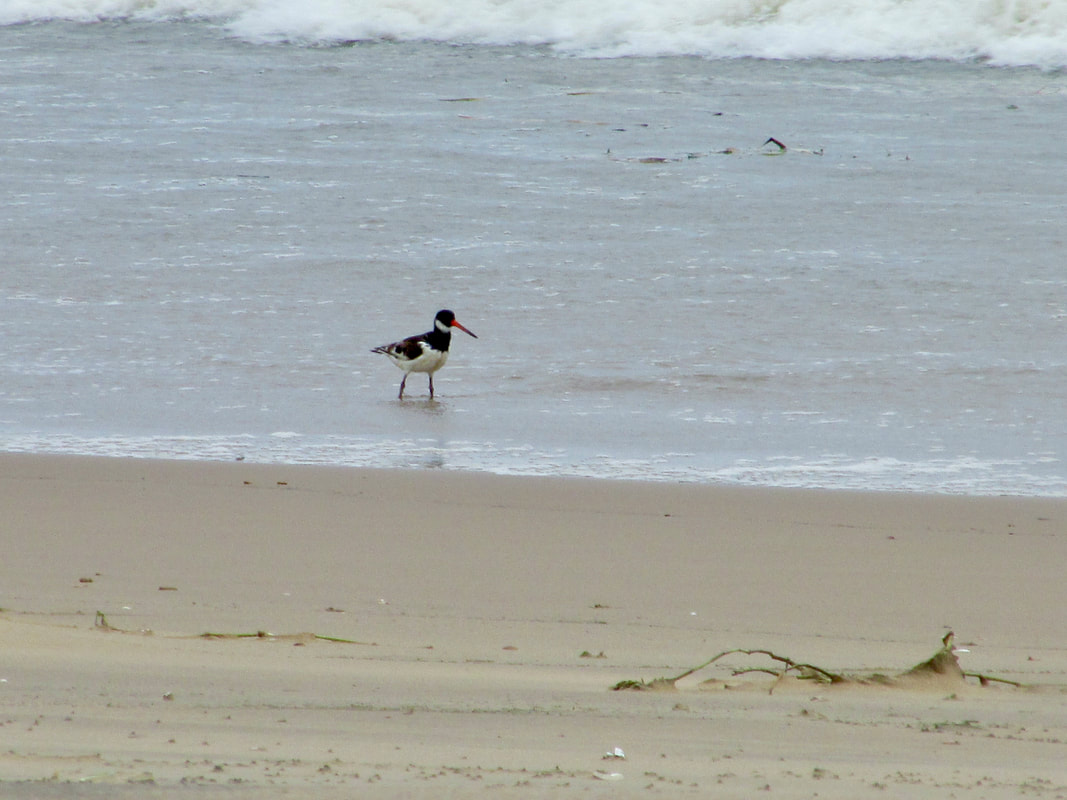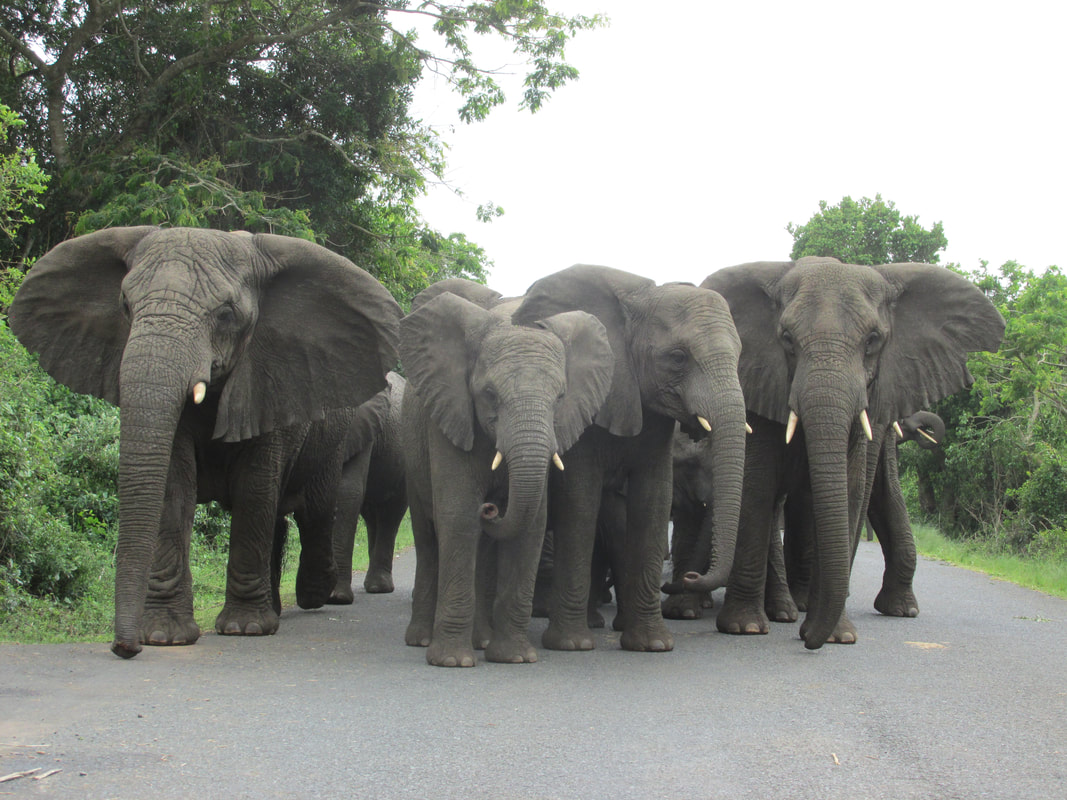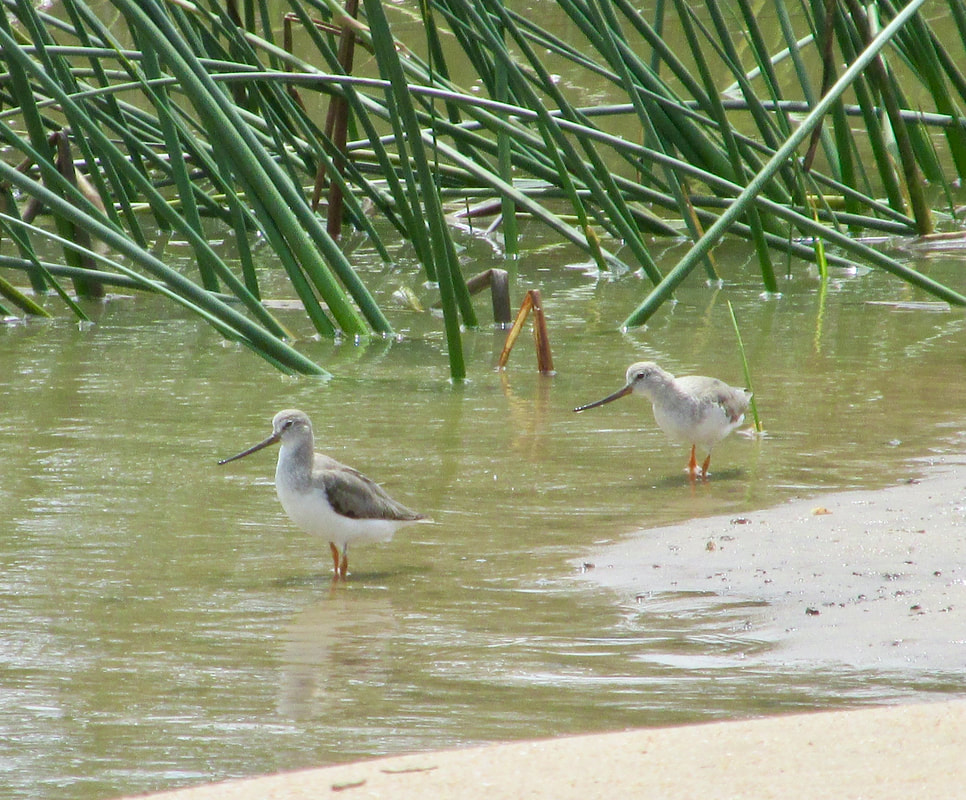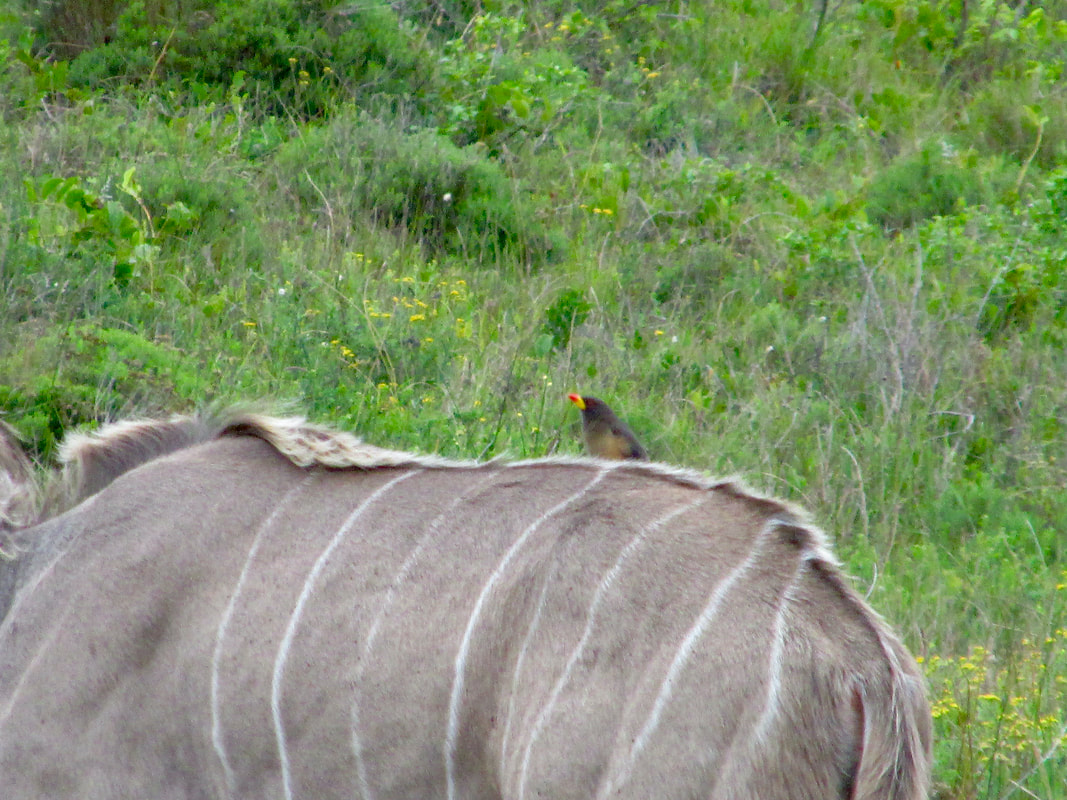|
It was a relatively wet June in St Lucia with approximately 100mm of rain falling during the month. Nevertheless, the wetlands have continued to shrink and the shallow remaining pans with more concentrated, easy to catch invertebrates, frogs and fish are attracting a nice variety of predatory waterfowl including Squacco heron, Saddle-billed stork, Striated heron, Little bittern, Great white, Intermediate and Little egret, Black-headed heron, Grey heron, African spoonbill, Hamerkop, Saddle-billed stork and Wooly-necked stork to name a few. There are also abundant African pygmy-goose, White-backed duck, White-faced whistling duck, Red-billed teal and the odd Blue-billed teal along with African jacana, Black crake, Reed cormorant and the odd patrolling African marsh-harrier. One of the highlights of the month has been the regular sightings of Rufous-bellied heron on the Eastern shores of Isimangaliso Wetlands Park. Another highlight has been the regular sightings of a Eurasian oystercatcher on the St Lucia beaches which has been in the company of African (Black) oystercatchers. Forest birding has been fantastic with regular sightings of Green malkoha, Olive bush-shrike, Blue-mantled crested flycatcher, Woodward's batis, Rudd's apalis, Eastern nicator, Buff-spotted flufftail, Spotted ground-thrush, Black-throated wattle-eye, Brown scrub-robin, Livingstone's turaco, Grey sunbird, Purple-banded sunbird and the odd White-starred robin (to name a few) At the estuary there has been a large tern roost present consisting predominantly of Greater crested terns with the odd Caspian, Sandwich and Little tern in the mix. The Western osprey has continued to show consistently as it hunts over the mouth and we have even enjoyed a sighting of African finfoot opposite the mouth in recent days! The Palm-nut vulture have also given us nice sightings on St Lucia beaches during the course of the month.
0 Comments
The criteria for deciding on the top ten birds were as follows: The distribution of the bird should be restricted predominantly to Zululand and/or Zululand should be the best place to see them in South Africa. Very localized species such as Green barbet were given preference over more widely distributed birds. The scarcity and level of difficulty in finding the birds ranked birds higher than others. For example Green malkoha is much more difficult to find than Rudd's apalis. 10. Livingstone's turacoLivingstone’s turaco are only found within Zululand and into Mozambique. Their preferred habitat is Dune forest and as such are restricted to the narrow band of Dune forest skirting the Indian Ocean North of St Lucia and into the Isimangaliso Wetlands Park. St Lucia, Sodwana bay and Kosi bay are the best place to see them. These birds are relatively common in suitable habitat, especially areas with fruiting fig and Wild plum trees. Their nervous habits make them tricky to get good visuals of but they are very vocal (especially late afternoon) which helps in locating them. 9. Rudd's apalisRudd's apalis are another species restricted to the Dune forest and sand forests of Zululand and into Mozambique. They are a very common and vocal species but their small size and furtive habits make them tricky to see. They favor areas with Dune thorn acacia and are often found in the company of the Yellow-breasted apalis which is much more confiding and conspicuous. 8. Woodward's batisWoodward’s batis are often described as the 'lazy' batis as they move less than the other batis species. They are often content to sit and call from the same position in dense foliage for long periods where their ventriloquil abilities make them difficult to locate. They are restricted to Dune forest and sand forest habitats skirting the coast of Zululand. St Lucia and the Isimangaliso Wetlands Park are the best place to see them. 7. Green malkohaAlthough Green malkoha occur further South than the Zululand border, Zululand is most certainly the best place to see this secretive and elusive bird. Their preference for thick tangles at forest edge and skulking habits make them very tough to see. They are often members of bird parties so patient scanning of trees in bird parties is a good tactic in finding this bird. St Lucia and the Isimangaliso Wetlands Park are the best place to search for Green malkoha. 6. Pink-throated twinspotPink-throated twinspot are best searched for in the sandforest areas of Mkhuze GR, Tembe Elephant Park and Bonamanzi but can also be found in dune forests of the Isimangaliso Wetlands Park at places such as St Lucia, Sodwana and Kosi Bay. They are often found in mixed flocks with other seedeaters such as Grey waxbill, Red-backed mannikin and Green twinspot. 5. Rosy-throated longclawRosy-throated longclaw favour damp grassland, floodplains and wetland edge on the Coastal plain of Zululand. They occur sparsely and are nomadic according to rainfall and suitable habitat. Good places to see them are Nibela peninsula, Hluhluwe river floodplain, the shores of Lake Sibaya and the Isimangaliso Wetlands Park. 4. Southern-banded snake-eagleWith only a few hundred individuals occurring in the Country, the Southern-banded snake-eagle is most certainly one of the most rare birds in South Africa. Their specific habitat preference of Dune forest restricts them to the far North-Eastern parts of Zululand with most individuals found in the extensive dune forests still remaining within the Isimangaliso Wetlands Park. The Eastern shores of Isimangaliso Wetlands Park and St Lucia are excellent places to search for this sparse and elusive bird. 3. Neergaard's sunbirdNeergaard's sunbird are restricted to the Sandforests of Zululand in places such as Mkhuze game reserve, Tembe elephant Park, Ndumo and the False bay section of the Isimangaliso Wetlands Park. They are a discrete sunbird which is easily overlooked. 2. Plain-backed sunbirdThe Plain-backed sunbird is an extremely localised bird found in Sandforests and tall woodland only in the furthest Northern reaches of Zululand (and further North into Mozambique). The only reliable place to see them in the whole of South africa is the Tembe elephant Park and its surroundings. 1. Green barbetOne of the most localised birds in the country, the Green barbet is restricted to the Ongoye forest West of the small town of Mtunzini in Zululand. The next nearest population of Green barbet is Southern Malawi and Northern Mozambique making it one of the most amazingly isolated and disjunct population of birds in the country.
Theories why the Green barbet does not occupy other surrounding forests is supposedly due to the occurrence of a high density and diversity of Fig tree species in the Ongoye forest compared to other nearby forests. The Green barbet is synonymous with fruiting figs which are its almost exclusive food source.  Bar-tailed Godwit at the Lake St Lucia estuary mouth. Bar-tailed Godwit at the Lake St Lucia estuary mouth. It's been a very dry month in St Lucia compared to last May when we received approximately 300mm of rain. The Wetlands have continued to shrink and the grasslands have become a swathe of golden yellow. With the lack of rain and reduced outflow from the imfolozi River the estuary channel has become much shallower. Most of the summer terns have now left the estuary mouth with a few stragglers of Lesser crested tern still persisting amongst the many Greater crested terns and Caspian and Sandwich tern. As is usual for the Winter we have started to see Cape Gannet out at sea (amongst the first arriving humpback whales) and also more Kelp gull and the odd Cape cormorant. Other species present at the mouth area throughout the month included: Pink-backed pelican, Yellow-billed stork, Sanderling, Grey plover, Little egret, White-fronted & Kittliz's plover.  Caspian, Greater crested and Lesser crested terns at the Lake St Lucia estuary mouth Caspian, Greater crested and Lesser crested terns at the Lake St Lucia estuary mouth The terns can rest easy these days with the absence of Yellow-billed kite but are still disturbed by the odd passing African fish-eagle and Western osprey. A nice surprise towards the end of the month was the discovery of a Eurasian oystercatcher which has joined a group of African Black oystercatchers on St Lucia beaches surrounding the Estuary mouth. Another nice surprise was a Bar-tailed godwit feeding amongst Eurasian whimbrels at the estuary mouth! In the forest we have enjoyed consistent sightings of Spotted ground thrush during the month and very reliable sightings of Buff-spotted flufftail in the latter part of the month. We have also enjoyed our first sightings of the season of the beautiful winter-visiting White-starred robin and Grey cuckooshrike. We also enjoyed somewhat unusual sightings of Brown-backed honeybird. Bird parties are nice and large after being beefed up by winter-visiting species such as Paradise flycatcher, Olive bush-shrike, Dusky flycatcher, Grey cuckooshrike and Black cuckooshrike. Early mornings are starting to become chilly and birds have started hunting the early morning sun which makes for good photographic opportunities. Frugivorous species such as Livingstone's turaco, Black-bellied starling, White-eared barbet, Trumpeter hornbill have been congregating around the last fruiting fig trees whereas sunbirds (Olive, Grey, Collared and Purple-banded) are congregating on the first flowering Tree fuschia and Cape honeysuckle. The short cut grass on the road verges on the Eastern shores are holding good numbers of Senegal lapwing and Wetland areas good numbers of Pale-crowned cisticola. Also of interest, Cuckoo hawk sightings have been nice and consistent on the Eastern shores during the month along with Southern banded snake-eagle, Brown snake-eagle and Black-chested snake-eagle.
It has been a relatively dry month for rainfall and the wetlands have started to recede once again. Zululand autumn is typically still warm and balmy but you can definitely feel a bit of a chill in the morning's these days. Other signs of the approach of winter are the arrivals of some of our winter-visiting birds. The grasslands are once again full of African stonechat and an ever-increasing number of Senegal lapwing. At wetland edges we are starting to see Pale-crowned cisticola and at the forest/grassland ecotone Fiscal flycatcher and Spotted flycatcher. In the forest we have started to see winter-visiting Olive bush-shrike and Chorister robin-chat. Besides those species that don't occur at all in the summer there are resident forest species such as Red-capped robin-chat and African paradise-flycatcher which are joined in the winter by others of the same species from other locations. These species are therefore much more plentiful in the winter months. Still looking forward to sightings of Spotted ground thrush, White-starred robin and Grey cuckooshrike which should be arriving soon (if not already). Winter-visiting Mangrove kingfisher have also started to appear at the estuary edges where there is an abundance of fiddler crabs, mangrove crabs and Mudskipper fish to feed on at the moment. In the forest, action has been centred at fruiting Large-leafed and Sycamore fig trees, Tasselberry trees and flowering African flame/Wild tulip trees and we have enjoyed great sightings of all the forest specials during the course of the month. Things have quietened down at the estuary mouth with the majority of summer-visiting waders having left but the tern roost typically still holds 5 or 6 tern species with good numbers of Lesser crested tern still present. Other species still regularly encountered at the mouth include African black oystercatcher, Western osprey, Palm-nut vulture, Eurasian whimbrel, Yellow-billed stork, White-fronted & Kittlitz's plovers. The wetlands are still holding good numbers of waterfowl including African pygmy-goose & White-backed duck and the odd Lesser moorhen and Saddle-billed stork. Sightings of the White-backed night-heron have dried up this month due to the receding wetlands. On the Eastern shores, a pair of Secretarybird have been a regular sighting during the course of the month and there have also been a couple of other uncommon birds sighted, namely, African crake and Cuckoo finch (both around Grassland loop exit). The Yellow-billed oxpecker also continued to show on their favourite herd of Kudu close to Dune loop exit. Raptor-viewing has been great again with regular sightings of Southern-banded snake-eagle, Brown snake-eagle, Black-chested snake-eagle, African crowned eagle, Martial eagle, African cuckoo-hawk and African marsh harrier and the odd Amur falcon in passage.
Yellow-billed oxpecker occurred historically in Zululand but quite quickly disappeared from the region in the late 1800's/ early 1900's (as well as the rest of South Africa). Their disappearance coincided with the onset of cattle-dipping with arsenical compounds, hunting of large herbivores (their symbionts) and the rinderpest outbreak in 1896 which wiped out huge numbers of large herbivores. The combination of fewer large herbivores and poisoning was too much for the population to handle.
As a result of this their range contracted Northwards to areas less affected by such practices and by 1915 they were considered to be locally extinct in South Africa, only occurring in the Northern reaches of Zimbabwe, Namibia and Botswana. With large herbivore numbers increasing, changes in dipping practices and better conservation measures the Yellow-billed oxpecker made a slow comeback into South Africa and started being recorded in the far Northern reaches of Kruger National Park from the late 1970's. For many years to follow in South Africa they were a bird only associated with the North of Kruger National Park. Over time their range has slowly started to expand Southwards again with birds reaching the Southern reaches of Kruger National Park. More recently there has been an ever-increasing number of sightings in Zululand. In recent years birds have been seen in Tembe elephant Park, Phinda game reserve, Manyoni game reserve and the Eastern shores of Isimangaliso. This indicates a likely re-population of the area. Interestingly, my most recent sighting on the Eastern shores was of 2 adults and a sub-adult which may indicate that they are even now nesting in the area. It's not often these days that you hear of positive species 'comebacks' and also shows that the rehabilitation of habitat and good conservation practices throughout Zululand are reaping rewards. It was an interesting weather month in St Lucia with plenty of rain (over 250mm). As a result the wetlands are full to the brim again and a few road sections on the Eastern shores of Isimangaliso Wetlands Park under water again. Tropical storm Filipo came very close to St Lucia, veering off to the ocean a few 100km to the North. Many birders were hopeful that Frigatebirds, Sooty terns or other vagrant pelagics might be forced closer to shore but none came ashore in St Lucia as far as I am aware. Unusual sightings during the month included: Yellow-billed oxpecker on the Eastern shores around Dune loop exit (on kudu again). Interestingly my last sighting was of 3 individuals (2 adults and a juvenile). A definite sign that they may be re-populating rather than it just being one lost individual! A Lesser moorhen has returned to its favorite spot in the wetlands 100m to the North of Amazibu hide. In the forest, the Buff-spotted flufftail have showed consistently throughout the month. We have also enjoyed regular sightings of Green malkoha, Black-throated wattle-eye, Blue-mantled crested flycatcher, Woodward's batis, Livingstone's turaco, Grey waxbill, Narina trogon to name a few. Towards the end of the month the season has started to shift with mornings and afternoons becoming cooler. Forest birds have started searching for the sun more making themselves more conspicuous! Plenty of action in the forest has been happening around fruiting Tasselberry & Fig trees and flowering African flame/Wild tulip trees. Seeding grass in forest clearings has been attracting a nice variety of seedeaters such as Red-backed mannikin, Grey waxbill, Common waxbill and Green twinspot. Significant changes have happened at the Lake St Lucia estuary mouth due to the large swell associated with the Tropical storm Filipo. The sandspit opposite the mouth pushed inwards and was levelled allowing more swell to cross over and scour the beach and reedbeds. No rarities were found at the mouth this month but there has been an impressively large tern roost consisting of Greater crested, Lesser crested, Common, Little, Caspian and Sandwich terns. With all the rainfall the Umflozi river (which connects to the estuary at the mouth) has been flowing strongly and pushing freshwater fish species such as Tilapia and barbel into the estuary channel (which then are forced onto the beach once they reach the saltwater) providing a feast for the many Yellow-billed storks (and crocodiles and Bull sharks) The Palm-nut vultures have continued to be regular on the estuary beaches and surrounds. In the grasslands, the first signs of the approach of Winter have come with the arrival of Stonechat, Senegal lapwing and even a Jackal buzzard. Also, The Blue-cheeked bee-eater have started to gather in large flocks in preparation for their Northward migration. Nocturnal birding has been great with regular sightings of White-backed night-heron, African wood-owl, Fiery-necked nightjar, Western barn owl and Spotted eagle-owl during the month. Raptor viewing was fantastic throughout the month with sightings of Crowned eagle, Brown, Black-chested and Southern-banded snake-eagle, Amur falcon, African fish-eagle, African goshawk, Black sparrowhawk, Little sparrowhawk, African cuckoo-hawk, Jackal buzzard and African marsh-harrier. A bonus during the month was many spectacular leopard sightings enjoyed on the Eastern shores, Isimangaliso.
It was an uncharacteristically dry February with only 62mm of rain (compared to 471 last year). The wetlands have shrank as a result but are still supporting good numbers of African pygmy-goose, White-backed duck, Great white & Intermediate egret, Red-billed teal, Yellowbilled duck, White-faced whistling duck, African jacana, Black crake, Striated heron, Little grebe. Collared pratincole are regular at Wetland edges within the Isimangaliso Wetlands park. The lake St Lucia estuary mouth has been rather quiet this month with no rarities showing up but still some excellent birding to be had. Palm-nut vulture have been seen at the mouth and surrounding beaches regularly -mostly singly and sometimes as a pair. Regular Terns at the roost have included Lesser crested, Greater crested, Little, Sandwich, Common and Caspian. Other regulars at the mouth this month have included Common-ringed, Grey and White-fronted plover, Sanderling, Common and Curlew sandpiper, Little stint, Common greenshank, Eurasian curlew, African black oytsercatcher, Western osprey, Southern brown-throated, Thick-billed & Eastern golden weaver; African reed & Lesser swamp warbler. The odd Sand martin was sometimes present amongst the many Barn swallows on the beaches surrounding the mouth. In the forest we have enjoyed great sightings of Narina trogon, Green malkoha, African emerald cuckoo, Black-throated wattle-eye, Woodwards batis, Grey waxbill, Green twinspot, Lemon dove, Tambourine dove, Garden warbler, Rudd's apalis, Livingstone's turaco, African pygmy-kingfisher and the other specials. More perseverance has been required (as is normal this time of year) due to many of the birds being less vocal and the forest being lush and dense. The Buff-spotted flufftail have been very consistent this month with regular sightings. In the grasslands we have started to see the a couple of Senegal lapwing As far as rarities go:
An African crake was discovered 1.5km North of the Isimangaliso Eastern shores entrance gate. Also of interest, nearby in Monzi (unfortunately on private land and therefore inaccessible), a Buff-breasted sandpiper and Pectoral sandpiper were discovered. Both huge rarities. It's been a great birding month in St Lucia again. Starting with some of the unusual sightings: On the 4th of January we saw a Yellow-billed oxpecker at the Dune loop exit on the Eastern shores, Isimangaliso. This follows a previous sighting at the end of October and is probably the same individual as it was in exactly the same location- also on a herd of kudu. On the 9th January a Dusky Lark was observed feeding on refuse on the main street of St Lucia. This is a very unusual record for St Lucia. In early January 3 African skimmer were discovered at the Estuary mouth but did not stay around for long. Last sighting was on the 12th Of January. At roughly the same time no fewer than 10 individuals were sighted in Richard's bay! Its encouraging that the skimmers have returned now for the second consecutive Summer (albeit for a shorter period this time). In the forest we have enjoyed good sightings of Narina trogon, Green malkoha, Woodward's batis, Livingstone's turaco, African emerald cuckoo, Rudd's apalis, Scaly-throated honeyguide, Brown scrub-robin, Green twinspot, Grey waxbill, Red-backed mannikin to name a few. The Livingstone's turaco are loving the fruiting Cape Ash trees at the moment. We enjoyed some special sightings of a pair of Narina trogon feeding their recently fledged chick, returning approximately every 15 minutes or so to feed it. Caterpillars, Leaf katydids and Cicada beetles were some of the food items observed being fed to the chick. We have observed a lone Pink-throated twinspot female throughout the month which is an uncommon bird in St Lucia (more typical of Sand forest). We enjoyed an interesting sighting of a pair of Crowned hornbill raiding the nest of a pair of Dark-backed weavers. The hornbills plunged their bills into the nest of the weavers whilst tried desperately to chase them off with no success. The wetlands are once again full to the brim after some heavy rains towards the middle of the month. Most have matured nicely and are covered in a carpet of waterlilies. African pygmy-goose and White-backed duck are present in the wetlands along with more common waterfowl such as Great white, Intermediate and Little egrets, White-faced whistling duck, Little grebe, African jacana, Black crake, Purple & Striated heron. Waders at the edges of the wetlands include Wood, Marsh and Common sandpiper, Common greenshank and Three-banded plover. Rufous-winged, Zitting, Croaking and Rattling cisticola are common at wetland edges along with the odd Collared pratincole, Fan-tailed widowbirds and Yellow-throated longclaws. At night time we have enjoyed fantastic sightings of White-backed night-heron at wetland edge close to St Lucia. The estuary mouth channel has continued to bend Northwards scouring the beach as it goes. This has created a nice long sand spit opposite the mouth channel a few hundred metres long. The sandspit is usually frequented by one (sometimes two) large tern roosts usually consisting of Greater crested, Lesser crested, Sandwich, Common, Little and Caspian terns. Other birds seen at the mouth during the course of the month have included Collared pratincole, Ruddy turnstone, African black oystercatcher, Grey plover, Goliath heron, Marsh sandpiper, Common greenshank, Eurasian whimbrel, Sanderling, Curlew sandpiper, Little stint, Common ringed plover to name a few. Western osprey, African fish-eagle and Palm-nut vulture are also regularly encountered. The reedbeds bordering the mouth are producing Southern brown-throated, Eastern golden and Thick-billed weavers as well as Rufous-winged cisticola, Lesser swamp & African reed-warblers. The dune scrub bordering the estuary is producing Blue-cheeked bee-eater, Brimstone canary and when morning offshores blow- mixed flocks of Barn swallow and Sand martin.
The forest has been on fire this month with some extraordinary sightings. Some highlights included 2 separate sightings of Buff-spotted flufftail females with chicks, Green malkoha courtship and mating, Multiple floating leks of Narina trogon & Blue-mantled crested flycatchers bravely defending their nest from a troop of Vervet monkeys. Most of the forest specials have shown nicely during the month with nice mixed flocks of Grey waxbill, Red-backed mannikin and Green twinspot encountered regularly as well as rowdy groups of Livingstone's turaco, inquisitive Yellow-rumped tinkerbird, Rudd's apalis, Woodward's batis, Brown scrub-robin, Purple-banded sunbird, Olive sunbird, Grey sunbird and Black saw-wing. Also some interesting nesting observations during the month- Grey waxbill using the discarded nest of a Spectacled weaver and Collared sunbird building their nest alongside a paper wasp nest (the wasps serving as a predator deterrent) At forest edge we have seen the return of summer-visiting Broad-billed roller and African pygmy kingfisher and the grasslands are once again full of summer-visiting Blue-cheeked bee-eater. The wetlands are still holding good numbers of African pygmy-goose, White-backed duck and the odd Lesser jacana and Lesser moorhen along with more common waterfowl. The Rufous-bellied herons are still regular on pan loop and at Amazibu hide on the Eastern shores. The Eastern shores has also produced regular sightings of Rosy-throated longclaw during the course of the month- always a treat The estuary mouth continues to produce some excellent birds, the highlights of the month being a Eurasian oystercatcher which has shown erratically and a single sighting of African skimmer. The Terek sandpipers and Bar-tailed godwit are also still lingering as well as the Saunders's tern which has proven difficult to see due to the terns often roosting further away to the South of the mouth. Other birds regular at the estuary mouth during the month have included Common ringed plover, Grey plover, White-fronted plover, Ruddy turnstone, Eurasian whimbrel, Common greenshank, Common sandpiper, Southern brown-throated weaver, Yellow-billed stork, Black heron, Little stint, Curlew sandpiper, Sanderling, Greater crested, Common, Sandwich, Little and Caspian tern, Kelp gull, Western osprey and African black oystercatcher. Lastly- not a bird but very special and worth mentioning- was the discovery of a 'Strawberry' leopard on the Western shores of Isimangaliso. There have been only a handful of sightings of this rare colour form of leopard in South Africa, making it very special for Isimangaliso Wetlands Park.  Male Narina trogon seen on a bird walk during the month Male Narina trogon seen on a bird walk during the month October is always a fantastic birding month in St Lucia. It has been an uncharacteristically wet October (350mm and counting) which has made birding challenging at times but the rain has topped up the wetlands nicely which bodes well for a great summer of wetlands birding. Also great for the continued opening of the estuary mouth. Another obstacle to birding at times has been the pesky elephants which block the road on the Eastern shores, Isimangaliso for hours! Birding has been great at the estuary mouth with the Saunder's tern still present amongst Common, Little, Greater crested, Sandwich and the odd Whiskered tern. Waders and other waterfowl seen regularly at the mouth this month include Terek sandpiper, Bar-tailed godwit, Common sandpiper, Common-ringed plover, Grey plover, Marsh sandpiper, Curlew sandpiper, Common greenshank, Sanderling, Pied avocet, Eurasian whimbrel, Ruddy turnstone to name a few. The wetlands have been productive with regular sightings of Lesser jacana, Lesser moorhen, African pygmy-goose, White-backed duck, Intermediate egret, Great white egret, African jacana, White-faced whistling duck, Saddle-billed stork and at wetland edges: Collared pratincole, Pale-crowned cisticola and Rufous-winged cisticola, Fan-tailed widowbird, Yellow-throated longclaw. The Rufous-bellied heron have persisted. In the grasslands we have seen the return of summer-visiting Common buzzard, Red-breasted swallow, Common (European) bee-eater, Blue-cheeked bee-eater and at the forest/grassland ecotone the return of African pygmy-kingfisher, Violet-backed starling, Broad-billed roller, Red-chested & Diederick's cuckoo. There has been lots of activity in the forest with birds more vocal and busy with the onset of breeding season. The Buff-spotted flufftail can be heard calling throughout the forest (especially on gloomy, rainy days and night) and we have been fortunate to find a couple of Narina trogon 'floating leks' of calling males. The Celtis leaf beetle larvae are no longer around which has made the African emerald cuckoo less abundant but there are still a few lingering amongst the Klaas' cuckoos. It has been a good month for seed-eaters with nice mixed flocks of Green twinspot, Red-backed mannikin and Grey waxbill in areas with good seed. A highlight this month was a sighting of Yellow-billed oxpecker on the Eastern shores, Isimangaliso. This bird historically occurred in Zululand but went locally extinct due to cattle dipping. For many years the only place to see them has been the Northern parts of Kruger National Park. There have been a couple of sightings in Zululand in recent years (Phinda & Tembe Elephant Park) which might indicate the gradual re-population of Zululand by these birds.
|





















